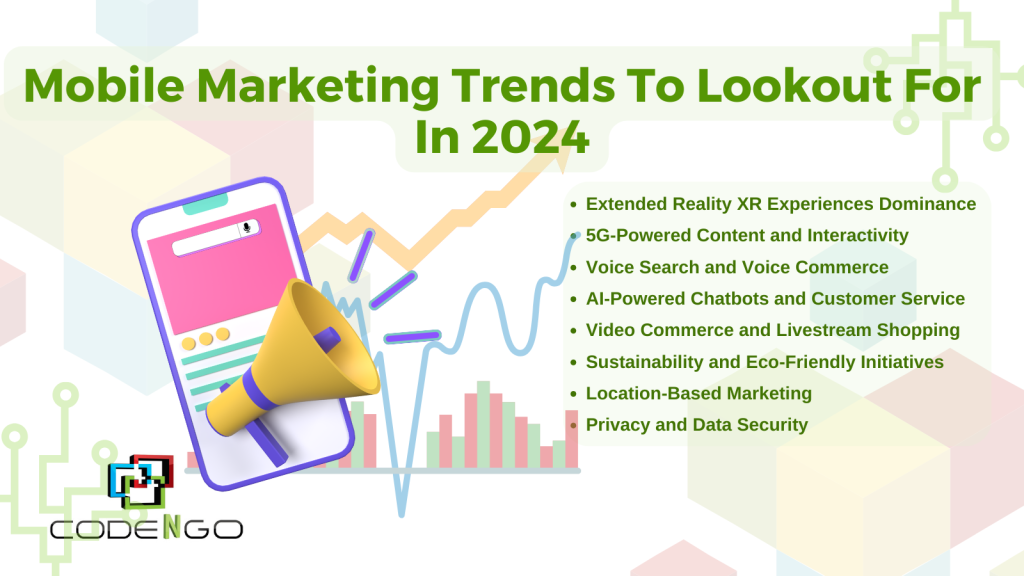Mobile marketing trends are constantly evolving, driven by advancements in technology and changing consumer preferences. As we enter 2023 and anticipate what lies ahead in 2024, it is crucial for businesses to stay abreast of the latest developments and challenges in the field.
by Liz Rustia

Let’s delve into the exciting trends and innovations that are shaping mobile marketing, all while considering the hurdles that marketers must overcome to succeed in this dynamic landscape.
Extended Reality XR Experiences Dominance
Extended Reality, a collective term that includes Augmented Reality (AR) and Virtual Reality (VR), is set to dominate mobile marketing. XR allows businesses to create immersive, interactive experiences for their users. Expect to see more AR-powered advertisements, VR-based product demos, and engaging XR-powered storytelling. This trend not only boosts user engagement but also fosters a sense of trust and loyalty. However, the high development costs, the need for specialized content, and the challenge of ensuring accessibility to a broad audience pose hurdles. For instance, a real estate company using AR to offer virtual property tours must invest significantly in creating high-quality, engaging content while ensuring it is compatible with a wide range of devices.
5G-Powered Content and Interactivity
The rollout of 5G networks presents remarkable opportunities for delivering high-quality, interactive content to mobile users. Faster download speeds, lower latency, and improved connectivity enable real-time, high-definition video streaming and engaging mobile experiences. Nevertheless, the challenges of infrastructure development, ensuring uniform network coverage, and persuading consumers to adopt 5G-compatible devices loom large. An example can be seen with mobile gaming companies that are eager to utilize 5G’s capabilities but must wait for a more widespread adoption of 5G-enabled smartphones and network infrastructure.
Voice Search and Voice Commerce
Voice technology continues to reshape the way users search for information and make purchases. Marketers are optimizing their strategies for voice search and voice-activated shopping, offering a new frontier for customer engagement. However, the challenges include privacy concerns, ensuring accurate voice recognition, and providing consistent user experiences across various voice-activated platforms. For example, an e-commerce company implementing voice commerce must address potential privacy issues and train its voice assistants to accurately interpret and fulfill user requests.
AI-Powered Chatbots and Customer Service
AI chatbots have become a staple in mobile marketing for offering quick, automated responses and enhancing customer support. The challenge here lies in striking the right balance between automation and human interaction. Customers still seek a personal touch, and overreliance on AI can lead to user frustration. An illustrative case is in the banking sector, where an AI-powered chatbot must seamlessly transition to a human agent when a complex or sensitive issue arises, ensuring that the user experience remains positive.
Video Commerce and Livestream Shopping
The integration of video commerce and livestream shopping is transforming how products are marketed on mobile devices. Live product demonstrations and shopping events create a sense of urgency and excitement among consumers. The challenge for marketers is to maintain authenticity and transparency while conducting real-time sales. A prime example is the fashion industry, where brands must ensure that the products and deals presented in livestream shopping events align with their overall image and are not perceived as deceptive.
Sustainability and Eco-Friendly Initiatives
Sustainability and eco-conscious marketing are gaining prominence in mobile marketing campaigns. Consumers increasingly appreciate brands that promote sustainable practices. However, the challenge lies in authentically embodying these values and ensuring genuine commitment to sustainability. For instance, a cosmetics brand using eco-friendly packaging must actively reduce its environmental footprint while transparently communicating these efforts to consumers.
Location-Based Marketing
Location-based marketing, which delivers context-aware content based on a user’s real-time location, offers personalized experiences. However, it also raises challenges related to user privacy and the risk of inundating users with irrelevant notifications. For example, a restaurant chain must carefully target users with relevant offers and discounts without invading their privacy.
Privacy and Data Security
With privacy regulations becoming more stringent, the protection of user data is a critical concern for both businesses and consumers. In 2024, mobile marketers must prioritize data security and transparent data usage to build and maintain trust with their target audience.
Mobile marketing trends for 2024 offer exciting innovations and challenges that can elevate marketing strategies to new heights. Yet, it’s vital to remember that alongside these innovations come unique challenges that marketers must address. Success in this dynamic landscape depends on a delicate balance between embracing innovation and navigating these challenges effectively. By acknowledging and actively managing these hurdles, businesses can maximize the potential of these mobile marketing trends and build stronger connections with their audiences.
As we move forward, one thing is clear: mobile marketing will continue to evolve, and those who embrace these trends will be at the forefront of innovation in 2024 and beyond.
Share this article on